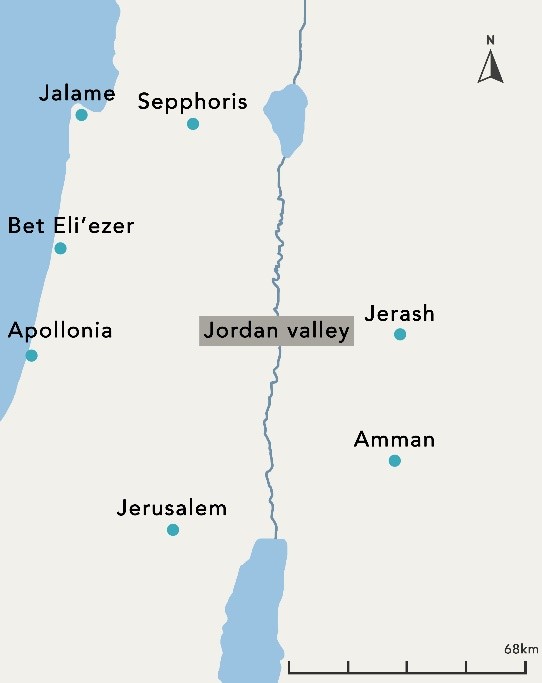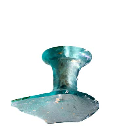Glass assemblage from ancient Gerasa unravels questions about ancient recycling and reuse in urban contexts
Elemental and isotopic analysis of glass from excavations in Gerasa (Jerash, Jordan) reveals new insights into supply sources and recycling intensity of this fascinating and fragile archaeological material.


The famous Decapolis city, Gerasa, prospered during the Roman, Byzantine and Early Islamic periods until a devastating earthquake in 749 CE led to its demise. During excavations in the Northwest Quarter of the ancient city (2012–2016), a Danish-German team found thousands of Roman and Byzantine glass fragments, of which a representative group has undergone analysis. The results of the major study have now been published in Journal of Archaeological Science and sheds light on glass supply and recycling processes in Gerasa and gives insight into economic regional and transregional exchange patterns.
Innovative analyses and the full potential of ancient glass
The glass assemblage was interpreted by an interdisciplinary team of specialists from Aarhus University, University of Münster, the Israel Museum and University College London. The exceptional level of recovery of the glass from the excavation, coupled with a comprehensive range of scientific analysis, made it possible to use new approaches to understand the ancient glass industry in the region and in particular the role of recycling in the ancient world. Glass reached Gerasa from as far away as Egypt and Mesopotamia.
“It has been really exciting to see the archaeological and scientific evidence come together to make such a convincing story,” said Dr Ruth Jackson-Tal of the Israel Museum. Another member of the team, Professor Ian Freestone of UCL Institute of Archaeology said: “Thanks to the advanced compositional analysis, we have been able to unravel the history of glass recycling at Gerasa. For the first time, we compare the activities of the recycling industries in different regions and show that glass recycling was more intensive away from the coastal trading routes.”
Today, glass recycling is of major environmental interest, as we strive to reduce our uses of energy and raw materials. The EU has a target to recycle 80% of its glass by 2030. “It seems likely that the Roman world got there before us,” said Dr Gry Barfod, the lead author of the study, and continued: “It is a sobering lesson.”
Glass from the Northwest Quarter of ancient Gerasa
The analysed glass was excavated by the Danish-German Jerash Northwest Quarter Project, directed by co-authors of the study Professor Achim Lichtenberger (University of Münster) and Professor Rubina Raja (Aarhus University). The project took a full quantification and in-context approach, which led to the documentation of all finds from all contexts in the small excavation, which only covered approximately 4 hectares of the middle-sized ancient city. The project has yielded more than 1,000,000 finds – most of which was pottery and has been studied already. The glass has been another focus, and with this publication the overall glass studies are brought to an end.
The new glass study is published in Journal of Archaeological Science and is the outcome of an international collaboration funded by the Carlsberg Foundation, the Danish National Research Foundation under Grant DNRF119 (Centre of Excellence for Urban Network Evolutions (UrbNet)) and Grant 26-123/8 (Niels Bohr Professorship in Geoscience), the Deutsche Forschungsgemeinschaft, Deutscher Palästina-Verein, the EliteForsk initiative of the Danish Ministry of Higher Education and Science and H. P. Hjerl Hansens Mindefondet for Dansk Palæstina-forskning.
Contact information
- Gry Barfod (Email: grybarfod@cas.au.dk; Phone: + 45 23 82 30 93)
- Ian Freestone (Email: i.freestone@ucl.ac.uk; Phone + 44 20 7679 7498)
- Achim Lichtenberger (Email: lichtenb@uni-muenster.de; Phone: +49 251 83 24545)
- Rubina Raja (Email: rubina.raja@cas.au.dk; Phone: + 45 27 18 83 90)
- Ruth Jackson-Tal (ruthjt@imj.org.il)
Full reference to original paper
Barfod, G. H., Freestone, I. C., Jackson-Tal, R. E., Lichtenberger, A. & Raja, R. (2022). "Exotic glass types and the intensity of recycling in the northwest Quarter of Gerasa (Jerash, Jordan)",
Journal of Archaeological Science, 140. DOI: https://doi.org/10.1016/j.jas.2022.105546.
Further information
The Danish-German Jerash Northwest Quarter Project:
https://projects.au.dk/internationaljerashexcavation/
Centre for Urban Network Evolutions (UrbNet):
